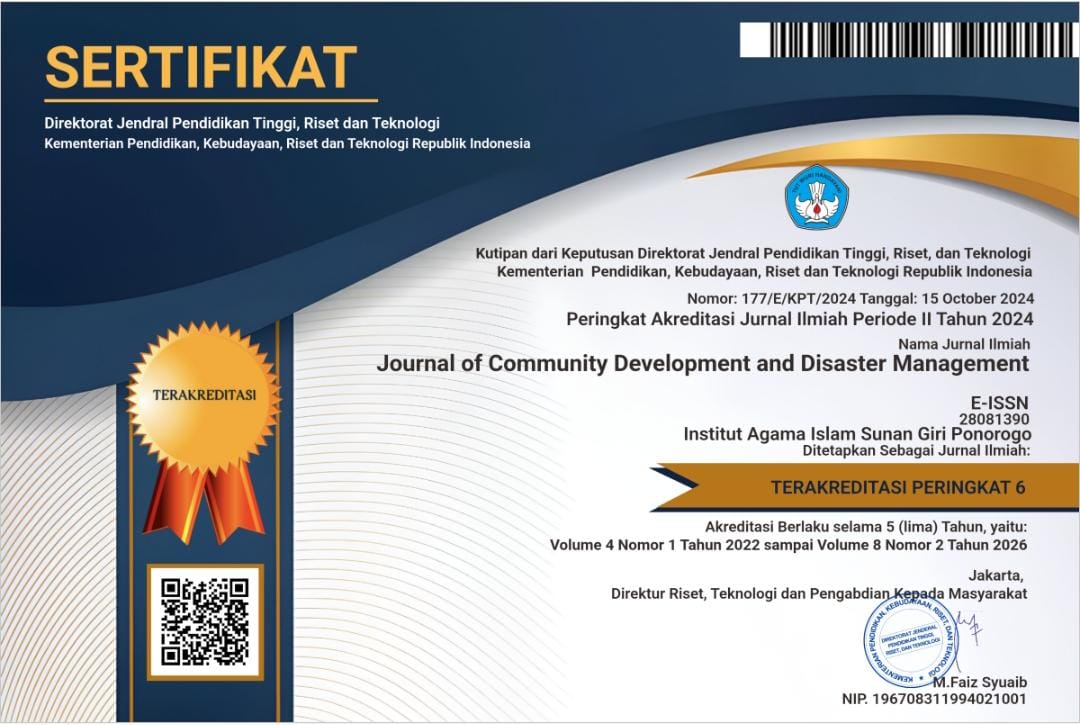LSTM-Based PM2.5 Prediction Enhanced by Polynomial Features: Case Study in South Tangerang
DOI:
https://doi.org/10.37680/jcd.v7i1.6953Keywords:
LSTM, PM2.5, Polynomial Transformation, PredictionAbstract
The significant impact of air pollution, particularly PM2.5, has driven mitigation efforts to reduce health and environmental risks through more accurate prediction systems. In this study, a Deep Learning approach using the LSTM method with the addition of Polynomial transformation features is proposed to predict PM2.5 concentrations. Historical PM2.5 data from South Tangerang City, Banten, was used to train and test the model. The results show that LSTM with polynomial features effectively captures temporal and non-linear patterns in the data, producing accurate and consistent predictions for both training and testing data compared to conventional machine learning methods such as XGBoost and SVR. Polynomial feature transformation significantly improved model performance, as evidenced by the reduction in prediction errors and increased accuracy compared to LSTM without polynomial features. The model also demonstrates adaptability to sudden fluctuations in air quality data. Although the prediction results closely align with actual values, slight discrepancies may arise due to external factors or model limitations. Therefore, the LSTM approach with polynomial feature transformation is an effective and promising method for PM2.5 prediction.
References
Al-Khayat, M., Al-Rasheedi, M., Gueymard, C. A., Haupt, S. E., Kosović, B., Al-Qattan, A., & Lee, J. A. (2021). Performance analysis of a 10-MW wind farm in a hot and dusty desert environment. Part 2: Combined dust and high-temperature effects on the operation of wind turbines. Sustainable Energy Technologies and Assessments, 47. https://doi.org/10.1016/j.seta.2021.101461
Alshdaifat, E. (2020). The Impact of Data Normalization on Predicting Student Performance: A Case Study from Hashemite University. International Journal of Advanced Trends in Computer Science and Engineering, 9(4), 4580–4588. https://doi.org/10.30534/ijatcse/2020/57942020
Ayturan, Y. A., Ayturan, Z. C., & Altun, H. O. (2018). Air Pollution Modelling with Deep Learning: A Review. In Int. J. of Environmental Pollution & Environmental Modelling (Vol. 1, Issue 3).
Brokamp, C., Jandarov, R., Hossain, M., & Ryan, P. (2018). Predicting Daily Urban Fine Particulate Matter Concentrations Using a Random Forest Model. Environmental Science and Technology, 52(7), 4173–4179. https://doi.org/10.1021/acs.est.7b05381
Brownlee, J. (2020, August 28). How to Use Polynomial Feature Transforms for Machine Learning. Machine Learning Mastery.
Chicco, D., Warrens, M. J., & Jurman, G. (2021). The coefficient of determination R-squared is more informative than SMAPE, MAE, MAPE, MSE and RMSE in regression analysis evaluation. PeerJ Computer Science, 7, 1–24. https://doi.org/10.7717/PEERJ-CS.623
Doreswamy, Harishkumar, K. S., Km, Y., & Gad, I. (2020). Forecasting Air Pollution Particulate Matter (PM2.5) Using Machine Learning Regression Models. Procedia Computer Science, 171, 2057–2066. https://doi.org/10.1016/j.procs.2020.04.221
Drewil, G. I., & Al-Bahadili, R. J. (2022). Air pollution prediction using LSTM deep learning and metaheuristics algorithms. Measurement: Sensors, 24. https://doi.org/10.1016/j.measen.2022.100546
Grossberg, S. (2013). Recurrent neural networks. In Scholarpedia: Vol. 8(2).
Guo, Y., Cao, X., Liu, B., & Peng, K. (2020). El Nino index prediction using deep learning with ensemble empirical mode decomposition. Symmetry, 12(6). https://doi.org/10.3390/SYM12060893
He, R. (2024). A Review of Feature Engineering Methods in Regression Problems. Academic Journal of Natural Science Journal Home: Ajns.Suaspress.Org | CODEN: AJNSAE | NAAN, 1(1), 40704. https://doi.org/10.5281/zenodo.13905622
Hochreiter, S., & Schmidhuber, J. (1997). Long Short-Term Memory. Neural Computation, 9(8), 1735–1780. https://doi.org/10.1162/neco.1997.9.8.1735
Iwaszenko, S., Smolinski, A., Grzanka, M., & Skowronek, T. (2024). Airborne particulate matter measurement and prediction with machine learning techniques. Scientific Reports, 14(1). https://doi.org/10.1038/s41598-024-70152-9
Kanellopoulos, D., & Pintelas, P. E. (2006). Data Preprocessing for Supervised Learning. https://www.researchgate.net/publication/228084519
Kurniawan, J. D., Parhusip, H. A., & Trihandaru, S. (2024). Predictive Performance Evaluation of ARIMA and Hybrid ARIMA-LSTM Models for Particulate Matter Concentration. Jurnal Online Informatika, 9(2), 259–268. https://doi.org/10.15575/join.v9i2.1318
Lindemann, B., Müller, T., Vietz, H., Jazdi, N., & Weyrich, M. (2021). A survey on long short-term memory networks for time series prediction. Procedia CIRP, 99, 650–655. https://doi.org/10.1016/j.procir.2021.03.088
Mengintip Juara Bertahan Polusi Udara Tangsel, Buruk di Tengah Malam. (2024, July 31). CNN Indonesia.
Mohamad, I. Bin, & Usman, D. (2013). Standardization and its effects on K-means clustering algorithm. Research Journal of Applied Sciences, Engineering and Technology, 6(17), 3299–3303. https://doi.org/10.19026/rjaset.6.3638
Morapedi, T. D., & Obagbuwa, I. C. (2023). Air pollution particulate matter (PM2.5) prediction in South African cities using machine learning techniques. Frontiers in Artificial Intelligence, 6. https://doi.org/10.3389/frai.2023.1230087
Parvathi, S. S. L., Devi, A. B., Kulkarni, G. L., Murugan, S., Vijayammal, B. K. P., & Neha. (2024). Exploring Feature Relationships in Brain Stroke Data Using Polynomial Feature Transformation and Linear Regression Modeling. Journal of Machine and Computing, 4(4), 1158–1169. https://doi.org/10.53759/7669/jmc202404107
Priyanka, Kumari, A., & Sood, M. (2021). Implementation of SimpleRNN and LSTMs based prediction model for coronavirus disease (Covid-19). IOP Conference Series: Materials Science and Engineering, 1022(1). https://doi.org/10.1088/1757-899X/1022/1/012015
Rad, A. K., Nematollahi, M. J., Pak, A., & Mahmoudi, M. (2025). Predictive modeling of air quality in the Tehran megacity via deep learning techniques. Scientific Reports, 15(1), 1367. https://doi.org/10.1038/s41598-024-84550-6
Rodríguez-Sánchez, A., Santiago, J. L., Vivanco, M. G., Sanchez, B., Rivas, E., Martilli, A., & Martín, F. (2024). How do meteorological conditions impact the effectiveness of various traffic measures on NOx concentrations in a real hot-spot? Science of the Total Environment, 954. https://doi.org/10.1016/j.scitotenv.2024.176667
Shariah, A., & Al-Ibrahim, E. A. (2023). Impact of Dust and Shade on Solar Panel Efficiency and Development of a Simple Method for Measuring the Impact of Dust. Journal of Sustainable Development of Energy, Water and Environment Systems, 11(2). https://doi.org/10.13044/j.sdewes.d11.0448
Sharma, L., Singh, H., & Choudhary, M. P. (2025). Application of deep learning techniques for analysis and prediction of particulate matter at Kota city, India. EQA, 66, 107–115. https://doi.org/10.6092/issn.2281-4485/20687
Thangavel, P., Park, D., & Lee, Y. C. (2022). Recent Insights into Particulate Matter (PM2.5)-Mediated Toxicity in Humans: An Overview. In International Journal of Environmental Research and Public Health (Vol. 19, Issue 12). MDPI. https://doi.org/10.3390/ijerph19127511
Wang, X., Xu, Z., Su, H., Ho, H. C., Song, Y., Zheng, H., Hossain, M. Z., Khan, M. A., Bogale, D., Zhang, H., Wei, J., & Cheng, J. (2021). Ambient particulate matter (PM1, PM2.5, PM10) and childhood pneumonia: The smaller particle, the greater short-term impact? Science of the Total Environment, 772. https://doi.org/10.1016/j.scitotenv.2021.145509
Zhang, Y., Sun, Q., Liu, J., & Petrosian, O. (2024). Long-Term Forecasting of Air Pollution Particulate Matter (PM2.5) and Analysis of Influencing Factors. Sustainability (Switzerland), 16(1). https://doi.org/10.3390/su16010019
Downloads
Published
How to Cite
Issue
Section
License
JCD: Journal of Community Development and Disaster Management rekomendasi pencipta untuk memegang hak cipta tanpa batasan dan batasan pencipta untuk memiliki hak publikasi tanpa batasan, juga pemilik hak komersial atas artikel tersebut adalah pencipta.







